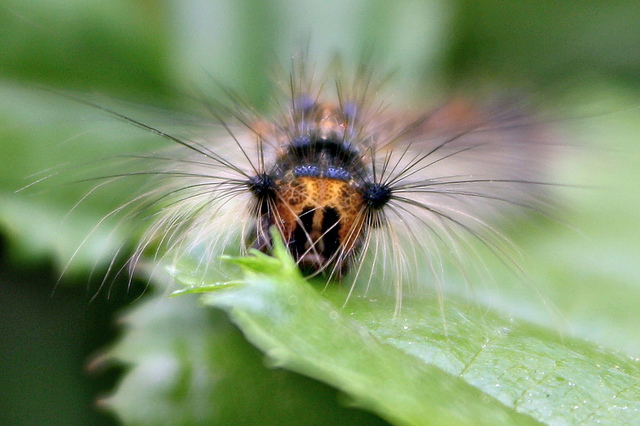Oh sure, it looks cute now, but he and about a billion of his friends want your whole forest for lunch | Photo: followtheseinstructions, CC BY-SA 2.0
***
So this morning I woke up to a post on r/skeptic about, well, so here’s the headline: “Seattle to Be Sprayed With GMO Bacteria, Agency Warns “Stay Inside After the Spray.” The comments section is… well, it is what it is. The usual fanaticism. “WE have found that WE CAN’T trust OUR govt, WHY should WE trust Monsanto or ANY chemical/drug companies?” and so forth. The website, “dcclothesline.com” has actually been flagged as a hoax/fake news site in the past, but what’s really interesting is that they are indeed spraying bacteria all over Washington State — and have been for decades.
It’s actually really cool. See, there’s this thing called the Gypsy Moth. It’s an invasive species that can result (and has resulted in the past) in massive deforestation, like the Emerald Ash Borer or the Pine Beetle that are both decimating forests in North America right now. Since we like trees, and since we don’t like it when forests turn from carbon sinks into carbon sources, we’ve been trying to stop it.
The best and least toxic way we’ve found to stop the Gypsy Moth is to aerially bombard great swaths of real estate with something called Btk, otherwise known as Bacillus thuringiensis kurstaki or the brand name Foray. We’ve been doing this since the 1970s. It’s not a GMO (at least, not so far as I can tell). Btk is a naturally-occurring bacterium that activates in the guts of the Gypsy Moth larvae and kills them in 7-10 days. There have been no proven health effects — negative or positive — on humans (which, if we’ve been dropping it on humans for over forty years is actually pretty surprising). A few people have complained of symptoms like mild rashes and itchy eyes, none of which can be linked to the actual spraying, but they advise people to stay indoor for half an hour after spraying just to be on the safe side.
Foray 48B is the name of the spray, and it’s just under 13% dormant Btk. The rest is non-pesticidal ingredients designed to make it stick to leaves, for instance. These ingredients are classified as “inert or other” and are tested over and over again by the EPA. Foray 48B is actually “food safe” (the most rigorously tested type of ingredients) because we use it on our produce. You’ve probably eaten some, if you eat fruits and vegetables.
It’s even allowed under the “organic” scheme run by the OMRI, a fact which will probably make some anti-science people’s heads explode.
Check out the Washington state Department of Agriculture’s website about it. It’s got plenty of links to helpful information, including this super-helpful FAQ by Oregon Public Health.
To repeat: this has been going on for decades, nobody’s been hurt, everyone’s being super-cautious just in case, there’s no evidence anyone is at any risk, and it stops a dangerous invasive species from wrecking the environment without using toxic chemicals.
I’d call that a win, but if you prefer dead forests and a plague of Gypsy Moths, you’re free to object.
Happy Monday, everyone.
***
Thanks for reading! I only get paid in my own (and your) enthusiasm, so please like This Week In Tomorrow on Facebook, follow me on Twitter @TWITomorrow, and tell your friends about the site!
If you like our posts and want to support our site, please share it with others, on Facebook, Twitter, Reddit — anywhere you think people might want to read what we’ve written. Thanks so much for reading, and have a great week.
***
Richard Ford Burley is a human, writer, and doctoral candidate at Boston College, as well as an editor at Ledger, the first academic journal devoted to Bitcoin and other cryptocurrencies. In his spare time he writes about science, skepticism, feminism, and futurism here at This Week In Tomorrow.

